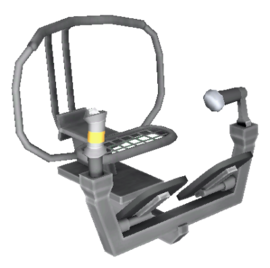EAS-1 External Command Seat
| EAS-1 External Command Seat | ||
| Command pod by Kerlington Model Rockets and Paper Products Inc | ||
| Radial size | Radial mounted | |
| Cost | (total) | 235.00 |
| (dry) | 200.00 | |
| Mass | (total) | 0.144 t |
| (dry) | 0.050 t | |
| Drag | 0.05 | |
| Max. Temp. | 1200 K | |
| Impact Tolerance | 6 m/s | |
| Research | | |
| Unlock cost | 8 100 | |
| Since version | 0.20 | |
| Part configuration | externalCommandSeat.cfg | |
| Crew capacity | (max) | 1 |
| Packed volume | 70 l | |
The EAS-1 External Command Seat is a Command Module for one Kerbal crew member during their mission. Unlike all others, this module is not a capsule, but a seat that can, for example, be attached to rovers. Thus it has no interior, no integrated SAS module or electrical storage capabilities, but can have a pilot in it when the mission starts.
A seated Kerbal adds 93.75 kg (0.09375 tons) of mass to a vessel and may cause problems when steering small rockets or rovers.
Contents
Usage
This module is designed for rovers but can also be used to control any other kind of vessel. It is also a convenient way for robotic vessels to ferry kerbonauts around.
To prepare it to control a vessel, move a Kerbal from a manned command pod into the seat by putting them on EVA, moving them close to the seat, and right-clicking it. As long as a Kerbal is sitting in the seat, it provides full command-module functionality, with the exception of doing crew reports (an EVA report can be conducted, however).
Vessels that are solely controlled by a seat must get a pilot from somewhere. There are three ways to do this:
- Launching just a manned command pod, putting the pilot on an EVA, walking them out of the launchpad area, and then launching the vessel with the seat.
- Adding a crewed, detachable command pod to the vessel.
- Since 1.5 Kerbals can be assigned directly from the editor. Thus helps reducing part counts, especially when performing specific missions or challenges where part count is a thing.
Since 1.4.3 the Kerbal can deploy his parachute without leaving the seat. This allows to construct paragliders that use Kerbal's parachute as a wing.
Product description
| “ | The EAS-1 External Command Seat provides all the controls needed to fully operate a spacecraft, just like a command pod, but without such needless frivolities as "pressurized interiors", or "seat belts". It's bare-bones, pedal-to-the-metal efficiency at its finest. — Kerlington Model Rockets and Paper Products Inc |
” |
Trivia
- Despite being a Command Pod, it cannot be a craft's central part because it can only be attached radially.
- Unlike other Command Pods, boarding the seat with a Kerbal will not refill the Pack Fuel of the Kerbal's EVA suit.
- Unlike other Command Pods, the seat cannot store the results of science activities. All experiments carried by a kerbonaut remain with the kerbonaut.
- Moderate torques, such as the pilot's helmet colliding with another object, can be enough to unseat the pilot.
- High airspeeds (650 m/s or more at sea level on Kerbin) is not a problem for a kerbonaut in a seat; but the kerbonaut adds a noticeable amount of drag to the craft.
- If a Kerbal is on the seat while the ship impacts, if this impact is not too rough, he can "die" but can be brought back to life by recovering the ship.
- Since to 1.5, kerbonauts can start on the seat
Changes
- A Kerbal can now be assigned to the seat in the VAB/SPH
- The Kerbal's parachute can be used without leaving the seat
- Initial Release

